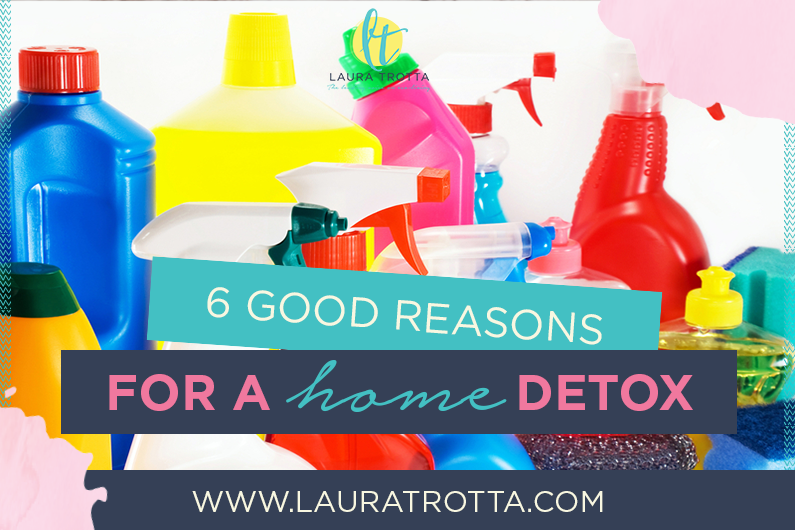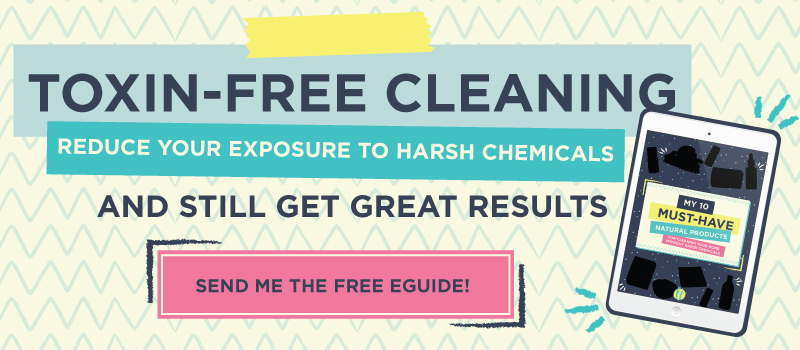If you’re unsure about whether or not you should make the effort to break up with toxins in your home, this post is for you!
Podcast: Play In New Window
Subscribe in iTunes
Like many women in their mid-thirties, I grew up in a household where every cleaning task boasted its own cleaning agent.
Windex was reserved for mirrors, White Lily for the stove top, Morning Fresh for washing the dishes, Domestos for the floors, Harpic for scrubbing the toilet, Shower Sparkle for the shower and Handy Andy for the bathroom. Mr Sheen came to the rescue when our wooden furniture required polishing, Mr Muscle made our benches shine, Sard Wonder Spray dissolved stains on our clothes and “You Can’t Wash in that Little Bucket” Dynamo was a powerhouse in our laundry.
I didn’t question this way of homemaking until I moved into a share house while studying at university. I simply couldn’t afford the luxury of a designated product for every household cleaning task on my modest casual waitressing wage. Instead, I purchased one or two heavy duty cleaning products that could handle most of the jobs; the same chlorine-based disinfectant cleaned my floors, toilets and bathroom. It was the mid 1990’s and eco cleaning products had yet to hit the market.
When eco cleaners started appearing on our supermarket shelves a few years later I had no hesitation purchasing them, even though they were more expensive than the conventional cleaning products. I was suffering from frequent migraines, was eager to break up with chemicals and these new eco cleaners were a convenient way to achieve this result.
I tested many different brands of eco cleaners over a few years, as some were more effective than others, until I realised that over time I had accumulated a separate product for most household cleaning applications again.
That didn’t seem particularly eco to me!
It was then when I truly started researching original green cleaning methods. You know, cleaning methods that were around before chemical cleaners infiltrated our homes. After all, homes were still clean before the 1950s and the explosion of home cleaning products, right?
I started experimenting with products such as baking soda (sodium bicarbonate), various essential oils, citric acid and white vinegar and was pleasantly surprised. I loved discovering that I could maintain a clean home using everyday products from my pantry.
I am now happy to report that we do not have harsh chemical cleaning products in our home, nor are our cupboards brimming with their eco alternatives. My migraines have gone from a weekly occurrence to a rare event and our “chemical” cupboards in the kitchen and laundry are almost bare, save for a few natural cleaning products.
Am I anti-chemical? Certainly not!
For 11 years I worked as an engineer in heavy industry and saw first-hand the value of chemicals in processing minerals that have undeniably improved our standard of living beyond our wildest dreams. I firmly believe that chemicals have a place in our modern society. I just believe that this place is in a controlled industrial setting, not in our homes.
Strict health and safety policies manage the exposure of industrial workers to chemicals. In a household context, chemicals are often used in and around young children, and this is mainly by women, who may be pregnant or breastfeeding. There is a risk that safety precautions may not be taken at a household level to the same degree as they would within an industrial setting.
Moving to a chemical-free home has many benefits, six of which are outlined below.
1. Your kids won’t be guinea pigs
It’s a concerning fact that many of the 40,000 individual chemicals that are permitted for use in Australia have never been assessed by the National Industrial Chemicals Notification and Assessment Scheme, the chemical safety regulator. According to a review by Choice, this is primarily because they were in use prior to 1990. They have been considered safe simply because they’ve been used for a reasonable period of time without known adverse effects, not because detailed testing has approved their safety. Giving your home a chemical detox ensures that your children, and you, aren’t participating in an ongoing, large-scale science experiment.
2. You will save money
It’s a no-brainer that buying different commercial cleaning products for various household tasks adds up financially. A chemical-free home doesn’t mean you stop cleaning your home, it just means that you become a little smarter when selecting the products you use to clean your home. This may involve making your own cleaning products from cheaper, readily available natural products.
3. Your home will be less cluttered
Cleaning without commercial chemicals means having less chemical cleaning products to store and we could all do with a little more cupboard space!
4. Your kids immune systems will be stronger
Products claiming to kill more than 99% of germs have gained in popularity in recent times. The issue with these is that in addition to removing all the bad germs from our homes, they remove the good germs; those that build up our immune systems and are beneficial to our health. As a result, children today who have grown up in sterile, germ-free households are less hardy and have lower resistance to bugs than kids of past generations. It’s one of those examples where advertising has appealed to our desire to provide a clean and safe environment, but in effect, may have caused the opposite.
5. Chemical-free is kinder to our planet
Many modern cleaning agents are made from petrochemicals, which is a non-renewable resource. When you stop and consider that every different product has been manufactured, transported to market, used, flushed down our drains and then, more often than not, the container disposed to landfill, it doesn’t take long to realise that our environment is paying a costly price for our love affair with all these chemicals.
6. You will reduce your child’s overall chemical load
Exposure to chemicals in everyday toxins has been linked to conditions including asthma, eczema, autism, dyslexia and attention-deficit hyperactivity disorder. By reducing exposure to chemicals in your home, you are lowering your child’s risk of developing such disorders.
Kids today are exposed to more chemicals in their everyday environment than at any other time in history. By creating a chemical-free home you can help reduce this burden. You will also go a long way to improving your own health and saving a few dollars along the way and not many people can argue with that!
This article was featured in Issue 35, August 2014 of My Child Magazine.
Keen to learn more? Join me and my amazing Home Detox Community in my popular Home Detox Boot Camp.
Podcast: Play in new window | Download
- Sustainable Home Design- factors to consider to maximise sustainability - July 28, 2022
- Advantage and Disadvantages of Tiny Houses - May 31, 2022
- How School Strike 4 Climate is Empowering Youth to Fight for Their Future - May 1, 2022



 Laura Trotta is one of Australia’s leading home sustainability experts. She has a Bachelor of Environmental Engineering, a Masters of Science (in Environmental Chemistry) and spent 11 years working as an environmental professional before creating her first online eco business, Sustainababy, in 2009. She has won numerous regional and national awards for her fresh and inspiring take on living an ‘ecoceptional’ life (including most recently winning the Brand South Australia Flinders University Education Award (2015) for the north-west region in SA and silver in the Eco-friendly category of the 2015 Ausmumpreneur Awards). With a regular segment on ABC Radio and with her work featured in publications like Nurture Parenting and My Child Magazine, Laura is an eco thought leader who’s not afraid to challenge the status quo. A passionate believer in addressing the small things to achieve big change, and protecting the planet in practical ways, Laura lives with her husband and two sons in outback South Australia.
Laura Trotta is one of Australia’s leading home sustainability experts. She has a Bachelor of Environmental Engineering, a Masters of Science (in Environmental Chemistry) and spent 11 years working as an environmental professional before creating her first online eco business, Sustainababy, in 2009. She has won numerous regional and national awards for her fresh and inspiring take on living an ‘ecoceptional’ life (including most recently winning the Brand South Australia Flinders University Education Award (2015) for the north-west region in SA and silver in the Eco-friendly category of the 2015 Ausmumpreneur Awards). With a regular segment on ABC Radio and with her work featured in publications like Nurture Parenting and My Child Magazine, Laura is an eco thought leader who’s not afraid to challenge the status quo. A passionate believer in addressing the small things to achieve big change, and protecting the planet in practical ways, Laura lives with her husband and two sons in outback South Australia. 


